Abstract
1. SK&F 104856 (2-vinyl-7-chloro-3,4,5,6-tetrahydro-4- methylthieno[4,3,2ef][3]benzazepine) is a novel postjunctional alpha 1- and alpha 2-adrenoceptor antagonist. 2. SK&F 104856 as well as prazosin and SK&F 86466 reduced blood pressure in the anaesthetized normotensive dog. 3. SK&F 86466 and rauwolscine but not SK&F 104856 or prazosin, produced a marked increase in myocardial contractility which corresponds with their ability to block prejunctional alpha 2-adrenoceptors. 4. Intravenous or oral administration of SK&F 104856 resulted in dose-dependent antihypertensive responses in 1-kidney, 1-clip (1-K, 1-C) Goldblatt hypertensive dogs with baseline blood pressure of approximately 140 mmHg. At 0.1 and 1 mg kg-1, i.v., mean arterial blood pressure fell by 11 +/- 5 and 23 +/- 5 mmHg, respectively. At 3 and 10 mg kg-1, p.o., blood pressure fell by 9 +/- 3 and 22 +/- 5 mmHg, respectively. At 10 mg kg-1, p.o., the antihypertensive effect of SK&F 104856 was still evident at 4 h. 5. The data indicate that SK&F 104856 shows selectivity in vivo for postjunctional versus prejunctional alpha-adrenoceptors and is a potent and long-acting antihypertensive agent in 1-K, 1-C Goldblatt hypertensive dogs.
Full text
PDF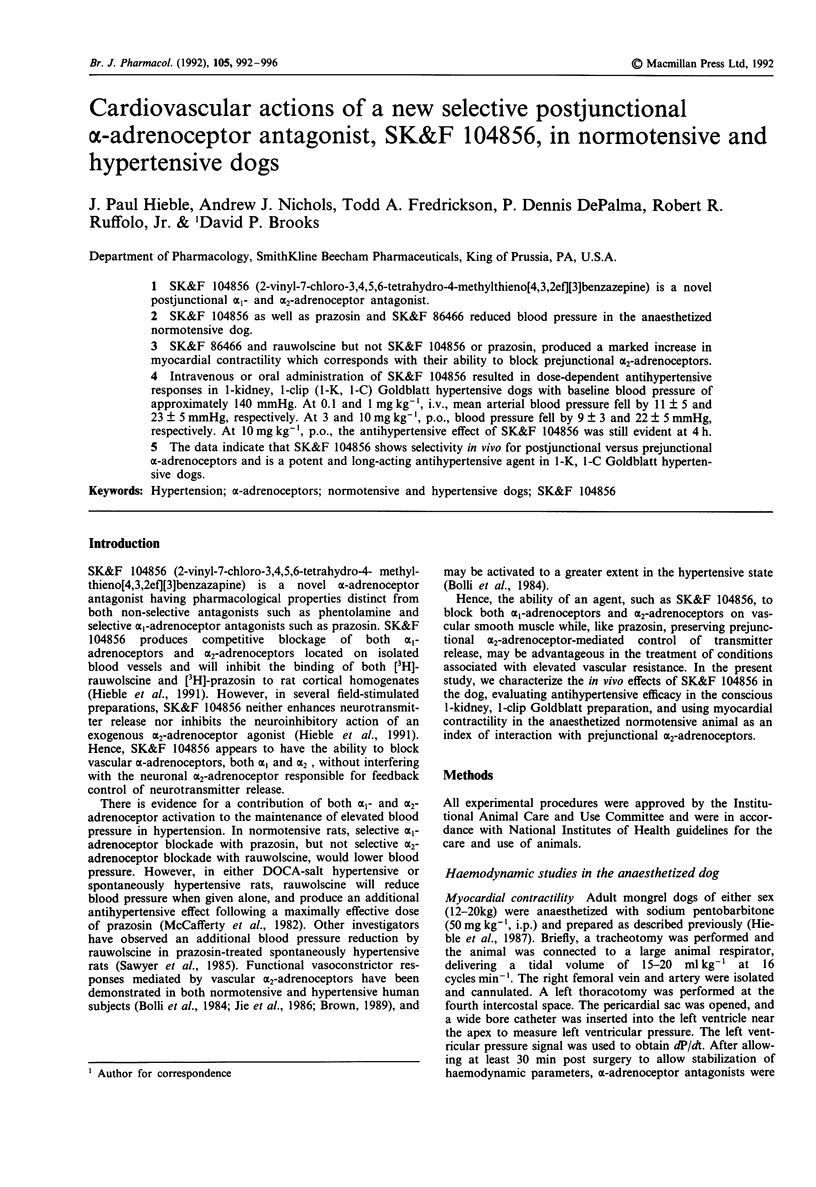
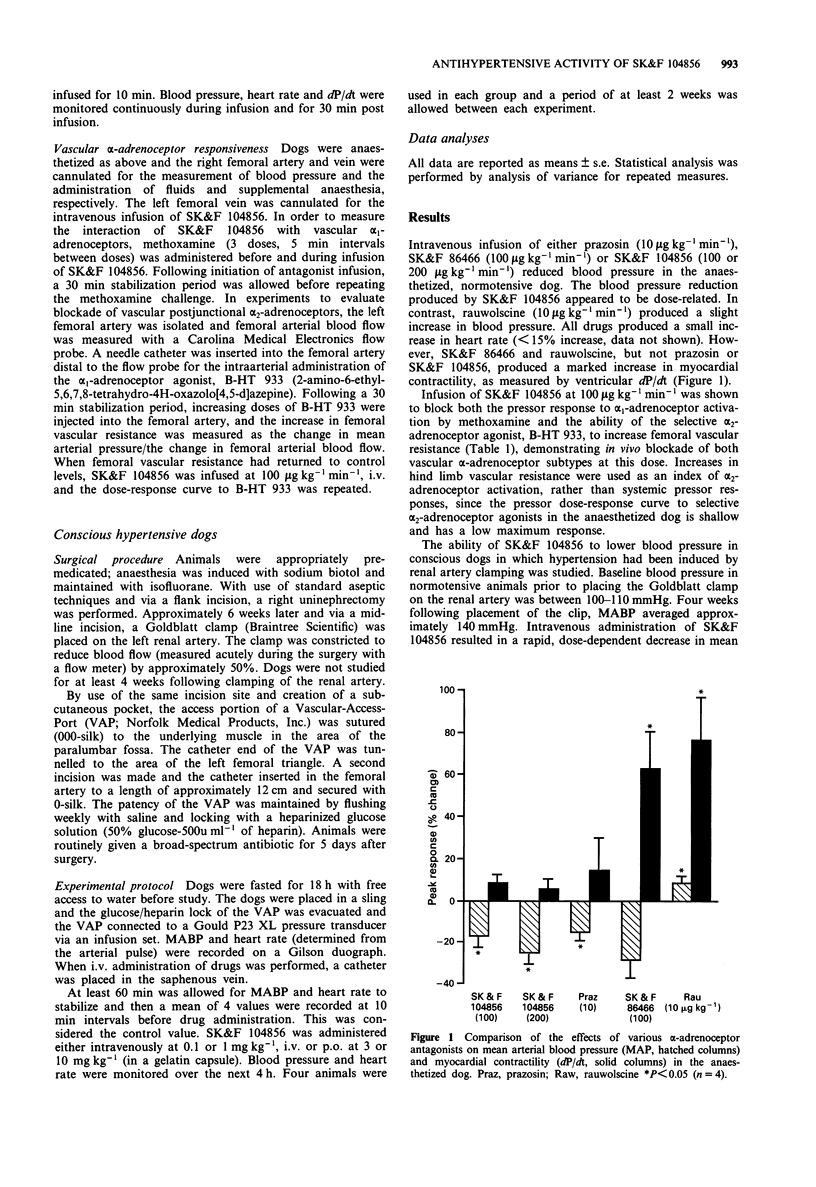
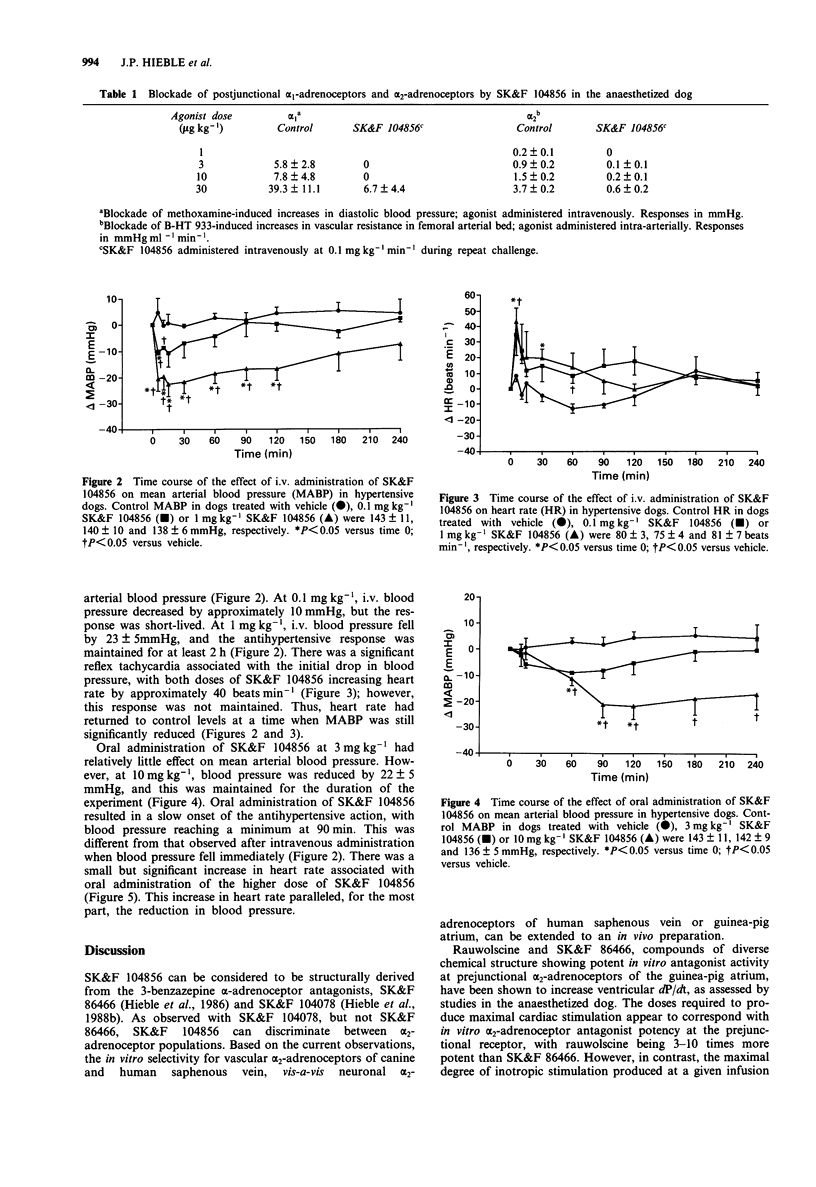
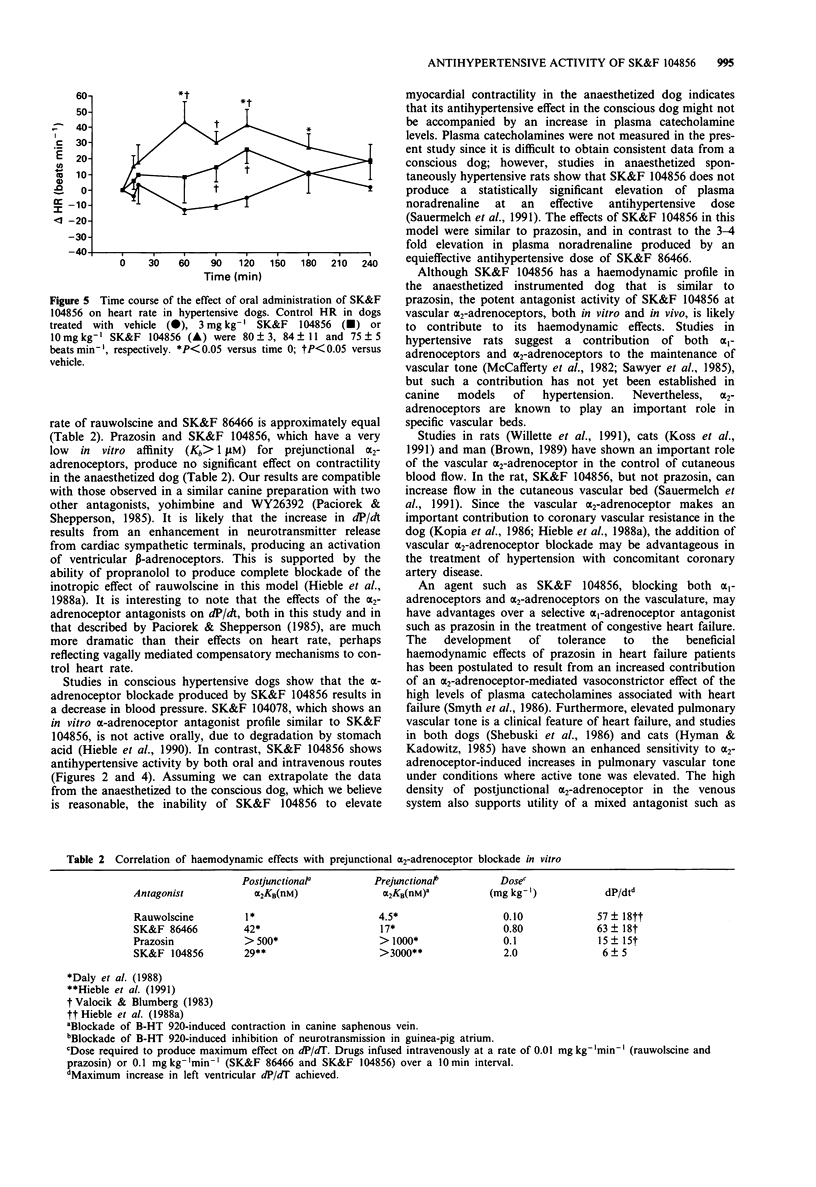
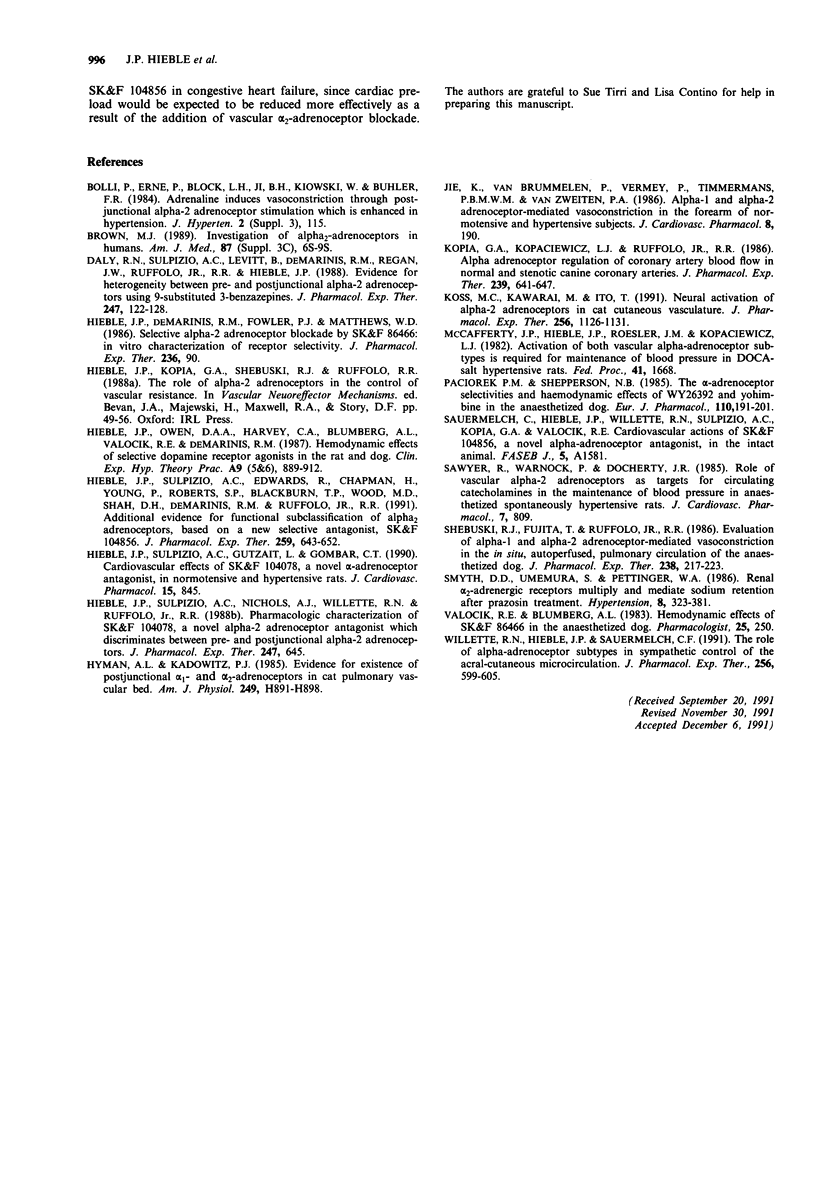
Selected References
These references are in PubMed. This may not be the complete list of references from this article.
- Brown M. J. Investigation of alpha 2-adrenoceptors in humans. Am J Med. 1989 Sep 18;87(3C):6S–9S. doi: 10.1016/0002-9343(89)90497-x. [DOI] [PubMed] [Google Scholar]
- Daly R. N., Sulpizio A. C., Levitt B., DeMarinis R. M., Regan J. W., Ruffolo R. R., Jr, Hieble J. P. Evidence for heterogeneity between pre- and postjunctional alpha-2 adrenoceptors using 9-substituted 3-benzazepines. J Pharmacol Exp Ther. 1988 Oct;247(1):122–128. [PubMed] [Google Scholar]
- Hieble J. P., DeMarinis R. M., Fowler P. J., Matthews W. D. Selective alpha-2 adrenoceptor blockade by SK&F 86466: in vitro characterization of receptor selectivity. J Pharmacol Exp Ther. 1986 Jan;236(1):90–96. [PubMed] [Google Scholar]
- Hieble J. P., Owen D. A., Harvey C. A., Blumberg A. L., Valocik R. E., DeMarinis R. M. Hemodynamic effects of selective dopamine receptor agonists in the rat and dog. Clin Exp Hypertens A. 1987;9(5-6):889–912. doi: 10.3109/10641968709161456. [DOI] [PubMed] [Google Scholar]
- Hieble J. P., Sulpizio A. C., Edwards R., Chapman H., Young P., Roberts S. P., Blackburn T. P., Wood M. D., Shah D. H., Demarinis R. M. Additional evidence for functional subclassification of alpha-2 adrenoceptors based on a new selective antagonist, SK&F 104856. J Pharmacol Exp Ther. 1991 Nov;259(2):643–652. [PubMed] [Google Scholar]
- Hieble J. P., Sulpizio A. C., Gutzait L., Gombar C. T. Cardiovascular effects of SK&F 104078, a novel alpha-adrenoceptor antagonist, in normotensive and hypertensive rats. J Cardiovasc Pharmacol. 1990 May;15(5):845–852. doi: 10.1097/00005344-199005000-00022. [DOI] [PubMed] [Google Scholar]
- Hieble J. P., Sulpizio A. C., Nichols A. J., Willette R. N., Ruffolo R. R., Jr Pharmacologic characterization of SK&F 104078, a novel alpha-2 adrenoceptor antagonist which discriminates between pre- and postjunctional alpha-2 adrenoceptors. J Pharmacol Exp Ther. 1988 Nov;247(2):645–652. [PubMed] [Google Scholar]
- Hyman A. L., Kadowitz P. J. Evidence for existence of postjunctional alpha 1- and alpha 2-adrenoceptors in cat pulmonary vascular bed. Am J Physiol. 1985 Oct;249(4 Pt 2):H891–H898. doi: 10.1152/ajpheart.1985.249.4.H891. [DOI] [PubMed] [Google Scholar]
- Jie K., van Brummelen P., Vermey P., Timmermans P. B., van Zwieten P. A. Alpha 1-and alpha 2-adrenoceptor mediated vasoconstriction in the forearm of normotensive and hypertensive subjects. J Cardiovasc Pharmacol. 1986 Jan-Feb;8(1):190–196. doi: 10.1097/00005344-198601000-00028. [DOI] [PubMed] [Google Scholar]
- Kopia G. A., Kopaciewicz L. J., Ruffolo R. R., Jr Alpha adrenoceptor regulation of coronary artery blood flow in normal and stenotic canine coronary arteries. J Pharmacol Exp Ther. 1986 Dec;239(3):641–647. [PubMed] [Google Scholar]
- Koss M. C., Kawarai M., Ito T. Neural activation of alpha-2 adrenoceptors in cat cutaneous vasculature. J Pharmacol Exp Ther. 1991 Mar;256(3):1126–1131. [PubMed] [Google Scholar]
- Paciorek P. M., Shepperson N. B. The alpha 2-adrenoceptor selectivities and haemodynamic effects of WY26392 and yohimbine in the anaesthetised dog. Eur J Pharmacol. 1985 Apr 2;110(2):191–201. doi: 10.1016/0014-2999(85)90211-0. [DOI] [PubMed] [Google Scholar]
- Sawyer R., Warnock P., Docherty J. R. Role of vascular alpha 2-adrenoceptors as targets for circulating catecholamines in the maintenance of blood pressure in anaesthetised spontaneously hypertensive rats. J Cardiovasc Pharmacol. 1985 Jul-Aug;7(4):809–812. doi: 10.1097/00005344-198507000-00029. [DOI] [PubMed] [Google Scholar]
- Shebuski R. J., Fujita T., Ruffolo R. R., Jr Evaluation of alpha-1 and alpha-2 adrenoceptor-mediated vasoconstriction in the in situ, autoperfused, pulmonary circulation of the anesthetized dog. J Pharmacol Exp Ther. 1986 Jul;238(1):217–223. [PubMed] [Google Scholar]
- Smyth D. D., Umemura S., Pettinger W. A. Renal alpha 2-adrenergic receptors multiply and mediate sodium retention after prazosin treatment. Hypertension. 1986 Apr;8(4):323–331. doi: 10.1161/01.hyp.8.4.323. [DOI] [PubMed] [Google Scholar]
- Willette R. N., Hieble J. P., Sauermelch C. F. The role of alpha adrenoceptor subtypes in sympathetic control of the acral-cutaneous microcirculation. J Pharmacol Exp Ther. 1991 Feb;256(2):599–605. [PubMed] [Google Scholar]


